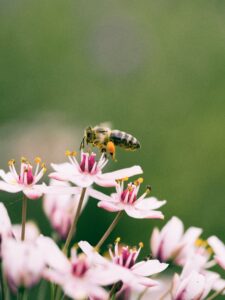The World Around Us:
Bees, the Great Pollinators
Did you know that NYS is home to more than 450 species of bees? The most common wild bee in NY is the digger bee, which represents more than 54% all of NY’s native bees. Digger bees, sometimes called miner bees, are part of the Apidae family which includes honey bees, bumble bees, and carpenter bees. Unlike the honey bee and bumble bee, digger bees live independent and solitary lives, leaving the female digger bee to construct her own nest.
While many native bees choose to nest in brush piles and hollow stems of woody plants, digger bees prefer to build their nests in loose sandy or loamy soil. They are excellent diggers, building nests in the ground that appear as small mounds or holes with an entrance and exit. The female lines the nest with an oral polyester-like secretion which will protect her eggs. After the female lays her eggs in the nest, the eggs will go through a complete metamorphosis and emerge as adults the following year.

Digger bees are a delight to gardeners. They are one of the most efficient pollinators in the ecosystem, pollinating a wide variety of flowering plants and having a wide range of foraging. They are a necessity to the reproduction of many native plants as well as gardens and crops. Digger bees are not aggressive and only the female is able to sting when provoked. Some homeowners, however, find the digger bee nests to be unsightly as they can interfere with turf growth. To discourage the digger bees from nesting in a particular area, simply water the area to keep the ground moist. The digger bee prefers dry areas and will move away.
In 2022, Cornell cited that more than 60% of NY’s bees are at risk of survival. If you want to discourage bees from your yard, find natural means. Determine and remove what is attracting them – flowering plants, bird baths, hummingbird feeders, standing water, anything that smells sweet. Keep yard clear of debris and brush piles. Use plants with strong and potent smells – marigolds, garlic, lemongrass, thyme, etc. Enlist a bee removal expert to remove any nests and relocate it. Avoid using pesticides, herbicides, and neonicotinoids. In 2024 Governor Hochul signed the Birds and Bees Protection Act which bans the use of neonicotinoid-treated corn, soybeans and wheat seeds, ornamental plants and turf in New York. The ban won’t take effect until January 1, 2029.
For those who want to encourage digger bees and other native bees to their environment here are some bee-friendly suggestions: plant a variety of native plants in your garden or on your patio; bees love bee balm, clover, and yarrow. Although dandelions are not a preferred food but fill a gap when other sources are not available, you might delay mowing a while in the spring. Keep a small basin of water amongst the plants with small stones so the bees won’t drown, lessen the size of your lawn, allow some part of your yard to be unkempt, and learn to love weeds.
The Bee Conservancy, New York Bee Sanctuary, New York City Beekeepers Association, NY Bee Wellness, and Cornell University are just a few of the organizations that provide resources for education and protection of bees in NYS.
New York State Humane Association Humane Review, Vol.XLV, Spring 2025.